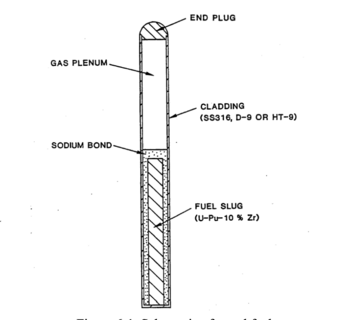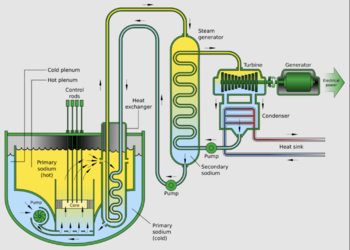Integral Fast Reactor
The Integral Fast Reactor is Argonne Lab's best design,[1] a metal-fueled, sodium-cooled, pool-type Fast Neutron Reactor, addressing all the issues raised in Nuclear_power_reconsidered (safety, waste management, weapons proliferation, and cost). "Integral" refers to the on-site reprocessing of the spent fuel.

Choice of Fuel and Coolant
The IFR has a unique design for its fuel rods, which allows larger burnup of the fuel, and provides inherent safety if the rod ever gets too hot. The fuel slug is loose in the cladding, and there is space above the fuel to contain gaseous fission products released as the fuel is consumed. See Figure 1. In standard fuel rods, the cladding must be tight around the ceramic fuel pellets to ensure adequate thermal conductivity and avoid overheating the fuel. This limits the lifetime of the rods, because the fuel swells and the cladding cracks as the gaseous fission products accumulate. The loose fit in the IFR rods is possible, because the gap is filled with highly conductive liquid sodium. Pure metallic fuel can be used, instead of oxides, because the sodium doesn't corrode the fuel or the steel cladding. If the metal fuel gets too hot, it melts and expands into the gas plenum, shutting down the fission reaction.
Safety
The safety of the IFR design is ensured by several features:
1) The metal fuel, a low melting point alloy of U-Pu-Zr, will melt if the rod ever gets too hot. The fuel then expands upward in the steel cladding, shutting down the fission reactions. See Fig.1.
2) Many of the fission products bind chemically with sodium, reducing the risk of fission product release if there is fuel failure.
3) The large pool of molten sodium will easily handle the decay heat after a shut-down. See Fig.2.
4) The reactor vessel has no penetrations below the top of the pool, eliminating the possibility of sodium leakage.
5) There is no high pressure or any water near the reactor vessel.
6) The entire reactor chamber can be flooded with Argon, eliminating the possibility of a sodium fire.
Test were conducted at Idaho National Laboratory in which the primary coolant pump was stopped with the reactor running at full power. The reactor shut itself down with no damage.[2]
Waste Management
Fuel rods have an advantage over molten salt fuels in that the fission products are contained in the rod. This means a smaller volume of radioactive spent fuel. Also rods are easy to identify and count, which may be advantageous in preventing diversion. A typical 500 MWe MSR produces 13 tonnes of Spent Nuclear Fuel (SNF) per year. A 500 MWe PWR produces ___ kg per year of SNF. A 500 MWe IFR produces ___ kg per year of (High Level Waste) HLW. Note: SNF can be reprocessed, and the final amount of HLW will depend on the details of that process.
Weapons Proliferation
Cost
Notes and References
- ↑ 1.0 1.1 Fig.6.1 in PLENTIFUL ENERGY The Story of the Integral Fast Reactor, CHARLES E. TILL and YOON IL CHANG, 2011.
- ↑ Cite error: Invalid
<ref>tag; no text was provided for refs namedtests
